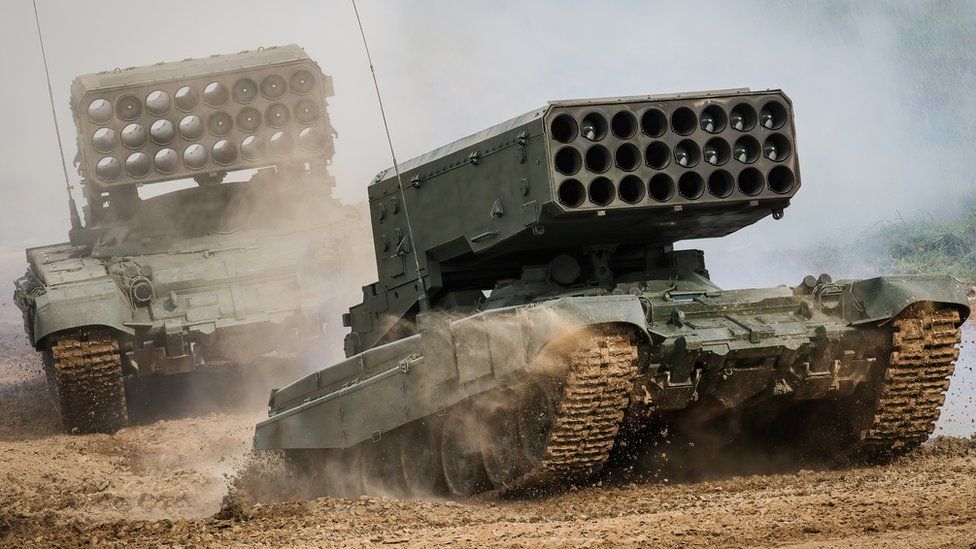What is a thermobaric or vacuum bomb?
- Published

Russia has used thermobaric weapons - also known as vacuum bombs - in Ukraine, says the UK's Ministry of Defence (MoD).
Thermobaric weapons are controversial because they are much more devastating than conventional explosives of similar size, and have a terrible impact on anyone caught in their blast radius.
Has Russia used thermobaric weapons in Ukraine?
In a tweet, the MoD said that Russia had confirmed the use of the TOS-1A weapon system in Ukraine.
It said: "The TOS-1A uses thermobaric rockets, creating incendiary and blast effects." The Russian military calls the units "heavy flamethrowers", which can fire rockets up to 9km.
Ukraine's ambassador to the US, Oksana Markarova, has also accused Russia of using them in its invasion.
How does a thermobaric bomb work?
A thermobaric bomb (also called a vacuum or aerosol bomb - or fuel air explosive) consists of a fuel container with two separate explosive charges.
This can be launched as a rocket or dropped as a bomb from aircraft. When it hits its target, the first explosive charge opens the container and widely scatters fuel mixture as a cloud.
This cloud can penetrate any building openings or defences that are not totally sealed.
A second charge then detonates the cloud, resulting in a huge fireball, a massive blast wave and a vacuum which sucks up all surrounding oxygen. The weapon can destroy reinforced buildings, equipment and kill or injure people.
They are used for a variety of purposes and come in a range of sizes - including weapons for use by individual soldiers such as grenades and hand-held rocket launchers.
Huge air-launched versions have also been designed, specifically to kill defenders in caves and tunnel complexes - the effects of this weapon are at their most severe in enclosed spaces.
In 2003, the US tested a 9,800kg bomb, nicknamed the "Mother of all bombs". Four years later, Russia developed a similar device, the Father of all bombs". This created an explosion equivalent to a 44-tonne conventional bomb - making it the biggest non-nuclear explosive device in the world.
Given their devastating impact, and their usefulness against defenders who are dug in to buildings or bunkers, thermobaric bombs have mainly been used in urban environments.
This is significant given developments on the ground in Ukraine, where Russian forces are trying to take control of the capital, Kyiv, and other main cities in the east of the country.
What are the rules of war for thermobaric bombs?
There are no international laws specifically banning their use, but if a country uses them to target civilian populations in built-up areas, schools or hospitals, then it could be convicted of a war crime under the Hague Conventions of 1899 and 1907.
International Criminal Court prosecutor Karim Khan has said his court will investigate possible war crimes in Ukraine.
Where have they been used before?
Thermobaric munitions can be traced back to World War Two, when they were initially used by the German army. They were not widely developed until the 1960s, when the US used them in Vietnam.
The US also used them in Afghanistan. First, in 2001 to try to destroy al-Qaeda forces hiding in the caves of the Tora Bora mountains, and in 2017, against Islamic State forces.
Russia used them in its war in Chechnya in 1999 and was condemned by Human Rights Watch for doing so.
Russian-made thermobaric weapons were reportedly used in the Syrian civil war by the regime of Bashar al-Assad.
Russia attacks Ukraine: More coverage
- LIVE: Latest updates from on the ground
- THE BASICS: Why is Putin invading Ukraine?
- RUSSIA SANCTIONS: 'If I could leave, I would'
- UKRAINE: Desperate scenes in Lviv train station
- IN DEPTH: Full coverage of the conflict